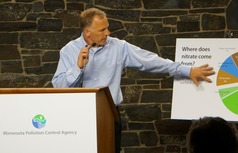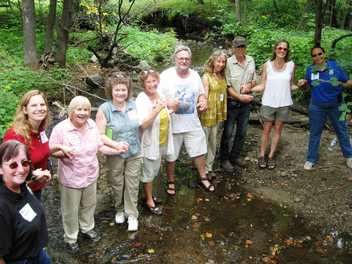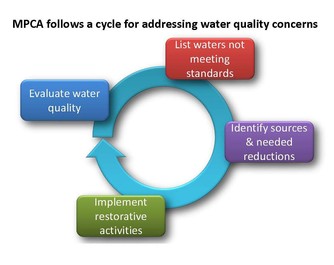|
The Minnesota Board of Water and Soil Resources (BWSR) is now accepting grant applications for funding from the Clean Water Land and Legacy amendment. The Board authorized the grant program at its Aug. 29 meeting. The grant application period will run through Oct. 4 with funds awarded at the Board’s January meeting.
Three funding categories from previous years will be requesting grant applications:
- Clean Water Assistance;
- Accelerated Implementation; and
- Community Partners Conservation Program.
If you would like to review information provided through the eLINK application webinars conducted earlier in August, please go to the eLINK Related Training section on the BWSR Training page.
Back to the top
 The Minnesota Pollution Control Agency (MPCA) is seeking public comment through Sept. 11 on its draft ballast water general permit. This state permit would continue the MPCA’s regulatory role in helping protect Minnesota waters of Lake Superior from potential environmental and economic harm caused by aquatic invasive species carried in the ballast water of ships.
The draft five-year state permit would affect 55 to 65 U.S.-flagged lakers (a "laker" is a vessel that transits only the Great Lakes), 60 to 65 Canadian-flagged lakers, and 225 to 275 ocean-going ships that transit through, and discharge to, Minnesota waters of Lake Superior.
The MPCA’s draft requirements focus on lakers’ treatment systems that, when installed, will minimize the introduction of new or spread of aquatic invasive species and submission of a Ballast Water/Sediment Management Plan. Once a ship’s plan is approved, the agency would issue a Notice of Coverage for the vessel.
MPCA Commissioner John Linc Stine said, “Lake Superior is not only valuable as a natural resource but also directly supports the entire region’s economy. This permit continues to make meaningful progress towards reducing the threat of aquatic invasive species while supporting a viable shipping industry.”
MPCA staff began working on the ballast water discharge program in early 2007 and issued a permit in September 2008. International efforts on this issue, federal court decisions, new requirements contained in the U.S. Environmental Protection Agency permit, new U.S. Coast Guard rules, and past state legislation helped shape the MPCA staff’s permit-development efforts.
A copy of the draft permit, fact sheet, and public notice are available for review at the MPCA offices in St. Paul and Duluth and online on the MPCA’s Public Notices webpage.
For more information, to request copies of the draft permit, fact sheet, and public notice, or to submit written comments until 4:30 p.m. on Sept. 11, 2013, contact Beth Gawrys, MPCA Industrial Division, 520 Lafayette Rd N, Saint Paul MN 55155-4194; send to her attention by fax at 651-296-8717; or email her at Elizabeth.gawrys@state.mn.us.
Back to the top
|
 The Mississippi River/Gulf of Mexico Watershed Nutrient Task Force holds public meetings throughout the Mississippi River Basin to inform the public of the progress toward moving forward on Gulf hypoxia. The next public meeting will be in Minneapolis on Tuesday, Sept. 24, from 8 a.m.-3:45 p.m. at The Depot Renaissance Hotel, 225 Third Ave. S. in Minneapolis. MPCA Commissioner John Linc Stine will give the welcome at the meeting, with Assistant MPCA Commissioner Rebecca Flood giving an overview on Minnesota’s state nutrient reduction strategy at 1:45 p.m. Other topics include:
- Size of the hypoxic zone;
- Applying social and economic science to state nutrient strategies;
- Role of foundations in nutrient reduction; and
- Cover crops.
Registration for the public meeting is available online.
The Task Force includes federal and state agencies and Native American tribes. Federal agencies include those with responsibilities over activities in the Mississippi River and its basin, and in the Gulf of Mexico. The role of the Task Force is to provide executive level direction and support for coordinating the actions of participating organizations working on nutrient management within the Mississippi River/Gulf of Mexico Watershed.
In Minnesota, nine state agencies are working to create a statewide strategy to reduce nutrients in Minnesota waters. A recent study led by the MPCA found that 158 million pounds of nitrate leave Minnesota in the Mississippi River per year on average, contributing to the “dead zone” in the Gulf of Mexico (see story below).
Being held concurrently with the Task Force meeting, CenUSA Bioenergy will hold a workshop on “Enhancing Mississippi Watershed Ecosystems with Perennial Bioenergy Crops” Sept. 23-25 in Minneapolis. CenUSA is a project based at Iowa State University with funding from the U.S. Dept. of Agriculture. Visit the workshop website for details and online registration.
Back to the top
|
 David Wall, a hydrologist and study coordinator with the MPCA, will present the agency’s "Nitrogen in Minnesota Surface Waters" study at the Mississippi River Forum Friday, Sept. 20, in St. Cloud and Thursday, Oct. 10, in Minneapolis. (Photo at right shows Wall presenting the findings at a press conference.)
Nitrogen is an essential component of all living things, but too much nitrogen in water can harm fish and aquatic life, pollute drinking water wells, and – once it leaves Minnesota via the Mississippi River – contribute to the oxygen-depleted "dead zone" in the Gulf of Mexico. A number of Minnesota's water bodies have elevated nitrogen, particularly in the southern third of the state. Earlier this summer, the MPCA released a comprehensive study that describes the sources, pathways, trends, and potential ways to reduce nitrogen in our waters. The study found that nitrate concentrations in the Mississippi River increased by 87-283 percent (depending on location) between 1976-2010, and that agricultural-related sources contribute more than 70 percent of the state's waters' nitrogen loads. The forum will focus on the findings of this ground-breaking study, as well as what's next for Minnesota's efforts to address this pollution source.
The Sept. 20 forum will be held from 8-9:30 a.m. at the St. Cloud City Council Chambers, 400-2nd Street South, St. Cloud, 56301, and the Oct. 10 forum, from 4-6 p.m., at the McKnight Foundation, 710-2nd Street South, Suite 400, Minneapolis, 55401.
There is no charge to attend the forum, but an RSVP to lark_weller@nps.gov is required.
Back to the top
|
The Minnesota Department of Agriculture (MDA) recently released a draft revision of the Minnesota’s Nitrogen Fertilizer Management Plan (NFMP) for public comment. This plan is the state’s blueprint for prevention or minimization of the impacts of nitrogen fertilizer on groundwater.
In 2010, MDA began the revision process to reflect current activities, interagency water protection programs and implementation work, and to better align it with current water resource conditions and programs. MDA convened a multi-stakeholder Advisory Committee and conducted a detailed analysis of issues related to nitrates in groundwater. The revisions were based primarily on input from the committee with consideration for past experiences with implementing the plan, input from related programs, increased knowledge about occurrences of elevated nitrate in groundwater, and advances in agricultural technology and management practices.
The plan includes components promoting prevention and developing appropriate responses to the detection of nitrogen fertilizer in groundwater. The strategies in the plan are based on voluntary Best Management Practices (BMPs). The Nitrogen Fertilizer BMPs were developed in 1990 and updated in 2007-08. They are available as University of Minnesota Extension publications.
A draft of the 2013 Nitrogen Fertilizer Management Plan is available for public review. MDA is requesting comments on the 2013 plan. Comments will be accepted through Nov. 1, 2013. To assist the public in understanding these issues and the plan, MDA will be hosting a series of public listening sessions across the state during the month of September. The meetings are free and open to the public.
Back to the top
The MPCA announces a public comment period through Sept. 17 on proposed changes to the Minnesota Nonpoint Source Management Program Plan (NPSMPP).
This plan contains strategies that help protect and improve the quality of Minnesota’s water resources by identifying activities to reduce nonpoint sources of water pollution, such as runoff from agricultural lands and unregulated urban areas.
The MPCA is implementing a four-year, phased approach for revisions to the 2008 NPSMPP. The following are highlights from the phase currently open for public comment:
-
Watershed Planning and Management Framework,
-
Overall Strategy for Each Water Resource,
-
Monitoring,
-
Nine Key Elements of a Successful Nonpoint Source Management Program, and
-
Needs, priorities and milestones, action plan tables for several areas.
Updating the NPSMPP every five years is a requirement for Minnesota to remain eligible to receive federal Clean Water Act funds.
For more information and copies of these documents, visit the MPCA’s Nonpoint Source Management Plan webpage.
All comments must be received in writing at the MPCA’s St. Paul office by close of business on Sept. 17. Comments should be sent to Denise Leezer, MPCA, 520 Lafayette Rd. N., Saint Paul MN 55155-4194 or to denise.leezer@state.mn.us. Questions may be directed to Leezer at 651-757-2523.
Back to the top
 The MPCA is seeking comments through Sept. 11 on a water-quality-improvement report for Minnehaha Creek and Lake Hiawatha in Hennepin County.
The report, known as a Total Maximum Daily Load (TMDL), focuses on pollution caused by E. coli bacteria in Minnehaha Creek and excess nutrients (phosphorus) in Lake Hiawatha. Both E. coli and excess nutrients impact aquatic recreation. The presence of E. coli in streams is an indicator of possible pathogens that, if ingested, can be harmful to human health. The excess phosphorus in lakes leads to algal blooms that may affect swimming and other recreation.
The predominant source of bacteria and phosphorus to Minnehaha Creek and Lake Hiawatha is stormwater runoff. The TMDL estimates that a 58-percent reduction in bacteria and a 30-percent reduction in phosphorus are needed. The TMDL report outlines various strategies for improving the waterbodies. These strategies primarily relate to improved stormwater management, such as ponds to capture and treat stormwater as shown in the photo above.
|
 The MPCA is also seeking comments on a TMDL report for the Snake River Watershed in east-central Minnesota (photo at right). The report focuses on pollution caused by excess bacteria and nutrients, mainly phosphorus. A public comment continues through Oct. 3.
The Snake River Watershed, which includes parts of Aitkin, Chisago, Isanti, Kanabec, Mille Lacs, and Pine counties, is a major watershed in the St. Croix River Basin. The report focuses on pollution impairments in three stream reaches (Upper Mud Creek, Lower Mud Creek, and Bear Creek) and four lakes (Knife Lake, Quamba Lake, Pokegama Lake, and Cross Lake) in the watershed.
The report indicates that nutrient reductions of between 25 and 73 percent, sediment reductions of 67 percent, and bacteria reductions of up to 72 percent will be needed at several locations throughout the Snake River Watershed to meet water quality standards.
A TMDL report is a scientific study that calculates the maximum amount of a pollutant a water body can receive, known as its "loading capacity," and still meet water quality standards. The TMDL reports are part of a nationwide effort under the federal Clean Water Act to identify and clean up pollution in streams, rivers and lakes.
After receiving public comments, the MPCA will revise the draft TMDL reports and submit them to the U.S. Environmental Protection Agency (EPA) for approval. Following EPA approval of the studies, the MPCA will work with local partners to develop plans to reduce pollution throughout the watersheds.
The TMDL draft reports are available at the MPCA’s St. Paul office, at 520 Lafayette Road N., and on the MPCA's Public Notices webpage.
Comments on the Minnehaha Creek and Hiawatha Lake report should be sent to Chris Zadak, MPCA, 520 Lafayette Rd. N., Saint Paul MN 55155, or by email to chris.zadak@state.mn.us. For more information, call Zadak at 651-757-2837 or 800-657-3864.
Comments on the Snake River report should be sent to Christopher Klucas, MPCA, 520 Lafayette Rd N, Saint Paul MN 55155, or by e-mail to christopher.klucas@state.mn.us. For more information, call Klucas at 651-757-2498 or toll-free at 800-657-3864.
Written comments must include (1) a statement of your interest in the draft TMDL report; (2) a statement of the action you wish the MPCA to take, including specific references to sections of the draft TMDL that you believe should be changed; and (3) specific reasons supporting your position.
Back to the top
|
The EPA recently approved the Total Maximum Daily Load (TMDL) report for Deer Creek in Carlton County in the Lake Superior Basin. The report focuses on pollution caused by turbidity. Sources of excess sediment entering Deer Creek include floodplain and streambank erosion, loss of riparian buffer from animal grazing, aging clay dam structures, road and trail crossings, and land use activities that change watershed cover. The MPCA will now work with local partners to develop a plan to reduce turbidity in Deer Creek.
Back to the top
 Recognizing that a significant portion of the Minnesota River basin lies outside Minnesota, a delegation from the Blueways nomination project headed upstream Aug. 26. They were warmly welcomed by hosts in Sisseton, S.D., and toured what some consider the true source of the Minnesota River.
In Sica Hollow State Park west of Sisseton, a little network of creeks tumble from the densely-wooded flanks of the prairie couteau, Buffalo Ridge. The rain and spring-fed streams form the Little Minnesota River, which accounts for about 90 percent of the inflow to Big Stone Lake – claimed to be the source of the Minnesota River.
The purpose of the delegation's visit was to engage support in South Dakota for the Minnesota River Blueways nomination. The visit opened with a lunch meeting at the Joseph Nicollet Tower Museum. The hosts learned about the Blueways project; the visitors learned about Dakota Indian history and the exploration of the area by Joseph Nicollet.
At Sica (pronounced 'See-cha') Hollow State Park, the group hiked the trails along the creeks, and heard more description of the area. "This is a spiritual place for the Dakota people," says Darlene Pipeboy, an educator and elder with the Sisseton-Wahpeton-Oyate Dakota community. "A combination of values brought the Dakota people here," she says. Woods, water, game, herbal medicines, the land, were all part of the native ecosystem. "Take care of nature, and nature will take care of you," Darlene says.
After a short stop at the historic Stavig House Museum in Sisseton, the delegation moved to the Sisseton City Hall for an open house gathering and potluck. Local guests and visitors heard a short overview of the Blueways project, and stayed for food and informal conversation with the visitors from Minnesota.
During a pause in the National Blueways program at the federal level, the Minnesota Blueways project continues to develop support, particularly among state and federal elected officials from all four states claiming portions of the Minnesota River basin. Organizers remain optimistic that eventually the Minnesota River will become the second in the U.S. to be recognized as a national Blueway. Visit the project website for more information.
In the photo above, delegates span the Little Minnesota headwaters. From left are Alice Hanley, Chantill Kahler-Royer, Cheryl Landgren, Cathi Fouchi, Sunny Ruthchild, Patrick Moore, Susan Armington, Gary Lentz, Anne Queenan and Connie Mueller.
Back to the top
|
The University of Minnesota offers several workshops through its Erosion and Stormwater Management Certification Program. These workshops are for facilities with industrial stormwater permits and for facilities excluded from permit requirements because they have no materials or activities exposed to stormwater (“no exposure”). Two upcoming courses are for facilities with sampling data results over permitted levels: Sept. 10 in Duluth and Nov. 18 in Shoreview. For more information or to register for these workshops, download the registration brochure.
Back to the top
"NOAA-supported scientists find large Gulf zone, but smaller than predicted" on the National Oceanic and Atmospheric Administration website
"Congress must close St. Anthony Falls lock" in the StarTribune
"Developing a strategic 25-year roadmap for clean water in Minnesota" on the Environmental Initiative website
"Ag Dept. seeks input on cutting nitrate levels in well water" on Minnesota Public Radio
"Minn. delays Lake Superior ballast water rules" on Minnesota Public Radio
"Inlet Protection," a short instructional video by the Minnesota Erosion Control Association with funding from the Minnehaha Watershed District
Back to the top
 As partners in water quality efforts, the MPCA thought you would be interested in this call for data. The MPCA will conduct surface water assessments – determining whether water bodies meet state water quality standards – for these watersheds in early 2014:
- Leech Lake River
- Pine River
- South Fork Crow River
- Zumbro River
- Red Lake River
- Red River - Grand Marais Creek*
- Lake of the Woods*
* Data requested only for the portions of these watersheds that are within the state of Minnesota.
The MPCA is interested in obtaining all available water quality data for these watersheds for use in the assessment effort. If you manage a water quality monitoring project in any of these areas, please submit your data, which will help the MPCA assess the condition of these waters and build a national database of water quality. Note the data submission timeline below to ensure that your data is available for the assessment process. To be included in the assessment effort, data must be received by the MPCA and uploaded to the agency’s water quality data management system (EQuIS) prior to data analysis. Be advised that steps involved in data storage for any project can span more than a month. Information on how to submit data is available on the MPCA website.
2013-2014 Data Submission Timeline:
- Through Nov. 1, 2013: Submit project lab and field data.
- Dec. 2, 2013: Begin final data review.
- Dec. 16, 2013: Complete final data review for assessment related data.
- Jan. 15, 2014: Data finalized and ready for the 2014 assessment process.
To ensure adequate time to process your data, you should provide your submittal to the MPCA EQuIS Team by Nov. 1, 2013. Your data will be entered into the EQuIS database and returned to you so that you can review it by Dec. 16, 2013. This is in order to guarantee the data are finalized by Jan. 15, 2014. Data received after Nov. 1 or reviewed after Dec. 16 may not be available to be used in the 2014 assessment cycle.
While the MPCA’s 2014 assessment effort will involve the seven watersheds listed above, the agency is also interested in receiving data from monitoring efforts in other watersheds. The MPCA uses submitted data for:
- Targeting watershed monitoring work;
- Identifying "stressors" that are causing or contributing to problems or threats;
- Managing and evaluating the success of ongoing implementation and resource management; and
- Helping plan for the next round of watershed monitoring.
In addition, the MPCA shares the data with local and state partners and interested parties via its Environmental Data Access (EDA) website and through the federal Environmental Protection Agency’s (EPA) national water quality data warehouse (STORET). Therefore, the agency encourages anyone with monitoring data to provide that data to MPCA for inclusion in the EQuIS database. Because of the watershed assessment timing, data from the identified watersheds will have first priority for processing into the system.
For additional information, contact the MPCA EQuIS Team:
-
Nancy Flandrick at 651-757-2361 (St. Paul, Rochester, and Mankato Regional Offices)
-
Jean Garvin at 651-757-2378 (Willmar, Marshall, and Detroit Lakes Regional Offices)
-
Lynda Nelson at 651-757-2601 (Duluth and Brainerd Regional Offices)
-
Stuart Arkley at 651-757-2567 (Water Quality Data Coordinator)
|
Background on using data to assess streams and lakes
 The federal Clean Water Act requires states to monitor and assess their waters to determine if they are supporting beneficial uses such as aquatic life and recreation. This law also requires states to publish a list of waters not fully supporting those uses (i.e., "impaired waters") every two years.
To meet these requirements, the MPCA monitors waters and gathers water-quality data from state, local and federal agencies, as well as citizens. The MPCA then conducts a rigorous process (assessment) to compare the data against water quality standards to determine if water bodies are supporting their beneficial uses. Waters not fully supporting their beneficial uses are identified as impaired and included on Minnesota’s 303(d) list of impairments (also known as the Total Maximum Daily Load, or TMDL, List).
In recent years the MPCA has transitioned from a statewide approach to a major watershed framework for assessment. Data analysis and assessment by MPCA staff is primarily organized by major watershed, following intensive monitoring of each watershed. This watershed monitoring schedule follows a 10-year rotating timeline. The major watershed framework allows for a comprehensive approach to assessment that considers biological, chemical and physical data together. Some pollutants, namely toxics, are still assessed statewide, because the data collection and management activities are more statewide in nature.
While assessment and listing still occur on an individual stream reach or lake basis, information about the overall health of the watershed is also captured to further inform management activities. The monitoring and assessment efforts culminate in the completion of a comprehensive watershed condition report for each major watershed, which conveys the available information about the health of the major watershed, subwatersheds and individual water bodies within each watershed.
Watershed assessments occur each winter, following the completion of the watershed monitoring. Statewide assessments occur biennially. Every other year, the watershed statewide assessment results are packaged together into the draft biennial 303(d) list of impairments. The draft list is placed on public notice, adjustments are made as warranted by public comment, and the final draft list is submitted to the EPA by April 1 of each even-numbered year.
Your role in collecting and managing the proper entry of these data into the MPCA’s water quality database is important to Minnesota’s effort to identify impaired waters and waters in need of additional protection, and to work with local, state and federal partners to protect and restore Minnesota’s waters. Thank you for your attentiveness to the data management process and the assessment timeline.
Back to the top
|
Waterfront is an email-based bulletin featuring updates on watershed funding, projects, events and research throughout Minnesota. Waterfront is published to share information with internal MPCA staff and external watershed partners.
The MPCA welcomes submissions from partners about funding opportunities, projects updates and upcoming events. Email submissions to catherine.rofshus@state.mn.us. Please note that the MPCA has switched to a new service, called GovDelivery, to deliver the Waterfront Bulletin. To ensure delivery of these messages, please add mpca@public.govdelivery.com to your address book or safe sender list.
Subscribe to WaterFront via Email Alerts, available at www.pca.state.mn.us/waterfront.
Cathy Rofshus
Public Information Officer
MPCA-Rochester-Mankato
507-206-2608
catherine.rofshus@state.mn.us
Back to the top
|